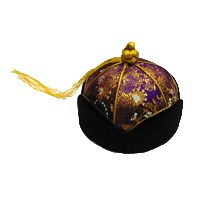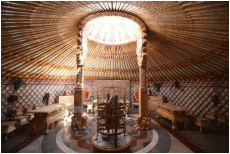Mongolian Culture
Mongolian nomads' homes, clothes, weapons, and way of life are impossible to imagine without Mongolia's unique crafts, patterns, and embroidery. A special aesthetic has developed from the common things used in the everyday life of nomads over thousands of years.
The beginning of the decorative arts in Mongolia dates back to pre-Bronze Age, with cave paintings. These can be found throughout Mongolia, but the highest concentration of cave paintings are in the mountains of western Mongolia, in the provinces of Hovd and Bayan Olgii.
The Bronze Age saw the development of molten metal and zooform art. An example are the "deer stones" one can find dotting the Mongolian countryside: stone slabs with simplified, stylized deer carved in relief. Fortunetelling conglomerations of animal figures and animal body parts characterized the art of the Hunnu and Bronze Age people who lived in Mongolian territory.
These peoples also decorated various cloth with embroidery, developed applique, and stitched felt art. Hunnu goldsmithing technology developed rapidly, and since their time, coin design has been paid special attention by the people of this area. The Hunnu also developed pottery techniques, such as creating vases by hand or by a turning method with a lock up mechanism. The Syanbi people made fur clothes and traveling bags with perforated embroidery, and their women wore tall headgear.
The Uhuani peoples' leaders were also their expert artisans: they were able to make bows and arrows, weapons, embroidery, woven items, and processed leather. During the Tureg Age, people created silver plates, golden jugs with floral motifs, and linear animal figures.
The Uighur people were an influential group who lived in the 8th century. They made gold earrings, horses' bits for the first time decorated by continuous ornament, and vases with wave motifs. People of the Khyatan state (911-1115) capably developed all kinds of craft and embroidery art because they viewed art and culture to be as important as politics and government. They elected wise leaders who were equally skilled in the making of weapons, saddle, bow and arrow, etc. Many stone masons lived in this century. Also during this time, a process of firing pottery in green, yellow, and black porcelain and enamel was developed.
During the time of Chinggis Khaan, traditional craft and embroidery art were enriched with influences from foreign cultures. Applique art was dedicated to Buddha and reached a classical degree of development. This art was an extension of the early folk embroidery in the countryside. To decorate the royal palace, exaggerated, stylized forms of animals on felt and silk were ornately embroidered. In the largest cities of Great Mongolia were many beautiful palaces decorated by such crafts and embroidery.
The 19th and 20th centuries made up an energetic period of development of craft and decoration. At the end of the 19th century, popular craftspeople, embroiderers, and artists gathered to create Ganjuur and Danjuur, two books of about 300 volumes, and Duinhor's Loilon. Tsam dance, a Buddhist religious dance, flourished in the time leading up to Communism, and many fine examples of the elaborate constumes used in the dances can be found in the Fine Art Museum and Choijin Lama's Museum. Mongolian paintings, sculpture, embroidery, felt art, leather art, bookmaking, Buddhist prints, and bone, wood, and fossil amber craft work developed powerfully in this time.
Mongolians revolted to gain independence from China and the Manchurians in 1911, and decided to renew the old monasteries and stations. The People's Republic of Mongolia was established in 1924 with the help of the Soviets, and in 1926, by unofficial census, there were 255 crafts people for silver, 297 for metal, and 85 for embroidery in Mongolia. Soon after, religion was banned in Mongolia and many monasteries and their inhabitants were destroyed. Mongolian crafts survived, though, with a new focus on supporting and promoting the Communist state. Starting intensively in the 1930s, craft art essentially separated from the herding life style and became an independent section of Mongolian art.
Today one can find Mongolian patterns decorating everything from ancient Mongolia jewelry to Soviet-style apartment buildings. There are 7000 different kinds of Mongolian patterns. Ancient patterns include "Sulden (emblem) khee" very widely used in Mongolia, and 'Galan (fire) khee." This is a very important pattern today because Mongolians honor Fire. Many Mongolian patterns symbolize the wishes and aims of Mongolians.
Mongolian Games
Popular board games are chess and checkers. The chess figures are noyon (noble) = king, bers (cp. bars "tiger") = queen, temee (camel) = bishop,mori (horse) = knight, tereg (cart) = castle, khüü (boy) = pawn.
The rules used today are the same as in European chess. Dominoes are also played widespread.
Indigenous card games existed in the 19th century but are now lost. One of the popular card games that is played is Muushig.
Sheep anklebones, or Shagai, are used in a number of different games, as dice, or as token.
"Rock, Paper, Scissors"- and Morra-like games are also played.
Wood knots and disentanglement puzzles have traditionally been popular.
The Mongolian children were also known to have played an ice-like game on frozen rivers that is similar to curling.
Traditional Costume
Culture of Mongolian national costumes is one of preciuos share of Mongolians to the world civilization. This culture was created during thousand of years in high mountains of central Asia together with genesis of Mongolians and research works proof that common appearance of the national costumes was formatted in the second century with strength of Huns empire.
The Deel
The main garment is the deel, a long, one-piece gown made from wool or silk. Most Mongolians have several different deels, appropriate for different seasons, as well as a more decorative deel for special occasions. Winter deels are often lined with sheep skin. The deel has a high collar, is often brightly colored, is worn with a multipurpose sash, and is worn by men and women year-round. Some men’s Deel have “nudarga” or a large trimming attached to the end of sleeves that can be overturned.
The fabrics used in Mongolian clothing such as silk, brocade, satin and velour reveal a connection of the Mongolian culture with other oriental cultures. Due to harsh nature, the lining for the winter dress consists of sheepskin, goatskin, or fur of wolves, lynxes, foxes, and sables.
Patterns, trimmings and colors of Mongolian dress have a lot of symbolism. They symbolizes the human qualities essential for living in the steppes such as simplicity, strength, prosperity, longevity, happiness and family values or represent Nature: sun or moon.
You will find below definitions and meanings of different garments and patterns that will help you browse through the collection in an informed way.
The conditions of climate excert influence on the kind of dress, the costumes for the seasons of the year. In summer the Mongols wear a light coat or frock, the "Terleg" (deel - summer coat), in spring, autumn and winter a wadded coat (row cotton), the "Khovontei Deel", or a lambskin coat, the "Khurgan Dotortoi Deel", in winter they wear a sheepskin dress reminding of a fur coat, the "Tsagaan Nekhii Deel".
The deel reflects the age of the wearer. The costumes of elderly people are, as a rule, modest and plain. The female dress shows differences between the attire of the girls and that of married women. The latter is decorated and adorned more splendidly with ornaments and jewellery. The design of the garments, the combination of colours as well as the decorative ornaments speak of an old tradition.
The Mongols wear the coat with the oblique border, the "Tashuu Engertei Deel", and the coat with the rectangular border, the "Durvuljin Engertei Deel". The materials from which the dresses were sewn were either produced by the people themselves, such as "leather, wool, and fur", or dresses have been made from silk, cotton, wool, and brocades and were richly decorated with jewellery and ornaments of gold, silver, corals, pearls, and precious stones.
Ethnic groups are differentiated by the color, decoration, and shape of their deel. Every ethnic groups has its own headdress (i.g. the "Toortsog", "Yuden", and "Zharantai"), hence there are many different kinds of caps and boots. The master (male or female) was able to glue, quilt, and stuff with wadding; he knew the symbolism of the ornaments used on the dresses, the symbolism of the colours and their combination.
The Khantaaz
The khantaaz is a shorter traditional jacket, often made of silk, which is also buttoned to the side, and usually worn over the deel.
It is usually worn outside of Deel. Is is usually made of thick warm fabrics. Khantaaz also has beautiful decorative trimmings.
The Gutal
The gutul is a high boot made from thick leather and sometimes decorated ornately. They are easy to put on - both the left and right boot are the same shape. There exist many explanations for the curled, upturned toe, but the most likely one is religious - the upturned end touches less earth and therefore theoretically kills fewer bugs, in accordance with Buddhist teachings about the non-taking of life.

Janjin is a men’s hat with a pointed peak, symbolizing prosperity and happiness, which rests on a dome-shaped base and is directed upward toward the sky.

Toortsog is a round cap that is usually worn by women during a warm season.
Lovuuz is a winter hat cut as two rectangular shapes sewn together with an opening at the back that is tied with little ribbons. It is trimmed of fox skin or other animals skin.
 Facebook
Facebook Twitter
Twitter Youtube
Youtube Pinterest
Pinterest Vimeo
Vimeo









